Page 2 of 5
OK, enough for a while about the kinds of knives I don't
use.
Here's my current collection of most-used knives:
At the lower left, you have my violin knives. These are the ones that really get
a workout in my shop. Directly above them is a knife I made after I saw a live demonstration
by Abel Garcia, a fine classical guitar builder from Paracho, Mexico. This guy can
really handle a knife! So, I traced his "cuchillo" and made myself
one just like it and mounted it in a handle. From time to time, I work with it, but
I must admit, I just haven't warmed up to the curved blade yet. But then, it's only
been a few years, and I get as stuck in my ways as anybody.
To the right, in front of my curved blade cuchillo, is a regular manual training
type "utility" knife. I have this one in the drawer to use when I'm cutting
open a box, or doing something that might injure my instrument knives. That is, I
have it in the drawer, or on the bench, or somewhere. . .
The knife I actually use for utility is my pocket knife, which is always in
my pocket when I need it. I've carried a pocket knife daily since I was seven years
old, and I feel positively nekkid without it! This knife is a "whittler"
style with three blades. In my case, that means three blades in varying degrees of
sharpness.
This is a photo of me scraping a little hollow area in the foot of a mandolin bridge:
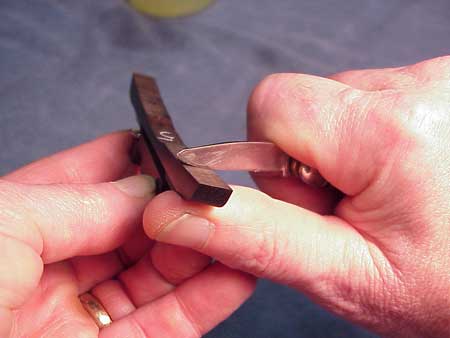
The curved blade is just perfect for the job, and I don't mind dulling the knife
by using it to scrape ebony. In case you don't know this little bridge fitting trick,
it's a matter of making the bridge "feet" slightly concave, so that they
are easier to fit to the top by rubbing on sandpaper fixed to the face of the instrument.
The little "pen knife" blade is perfect for deburring and other rough jobs:
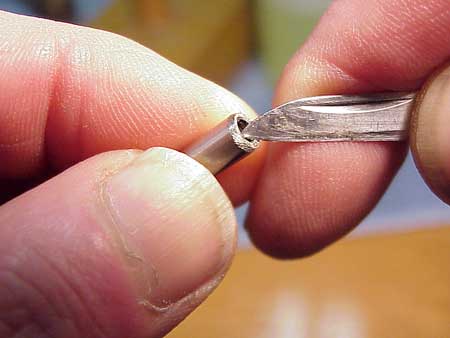
Here's a pocket knife buying tip: Go to a gun show. Gun and knife dealers usually
have boxes of "user quality" knives which they sell really cheap. You can
often pick up terrific bargains because the collectors are choking on quantities
of non-collectible high quality knives by top manufacturers.
The knife at the top of the group photo is a special one. It's
a Japanese knife used for splitting bamboo. I bought it because it looked interesting
in the catalog and it wasn't expensive. I use it for splitting spruce patch material
to avoid runout:

It works like a champ. I suspect, though, that any big old carving knife or cleaver
would work about as well, and would cost about half a buck at a garage sale. . .
Sharpening is important, for sure. The only thing is, I don't really believe in wasting
a lot of time trying to produce a perfect edge. As I use my knife, it becomes slightly
duller and I have to accommodate that as I go along. I don't like working with dull
tools, but I really don't want to spend all my time sharpening, either.
A I sharpen my violin knife, I try to maintain the acute cutting angle by holding
the bevel as flat as I can while rubbing it across my oilstone. I have a full selection
of Japanese water stones, but the reality is that the stupid old oilstone is in a
covered holder the one that's actually ready for use, so that's the one I use more
often. So, even though it's not as fine an edge, I get adequate results with my oilstone:
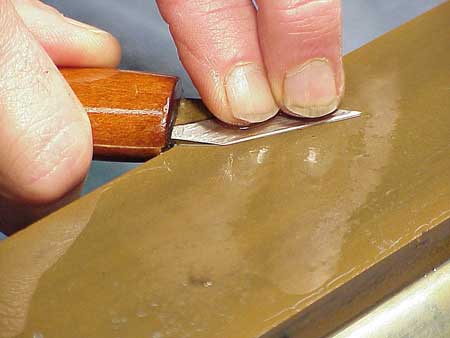
I'll give my knife a good going over with the water stones when I get around to setting
them up to sharpen my plane blades.
Oh, all right! Most of the time, I don't even get out the oil stone. I'm always in
a bit of a rush, so out comes the scrap of 1200 grit (or whatever) and I take a hike
over to the bandsaw:
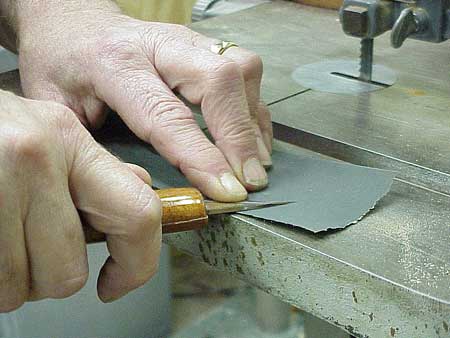
All my knives have really stout blades, especially when compared to the X-acto type
hobby knife or scalpel. That's the real reason I don't use hobby knives any more.
When my knife starts to get a bit dull, I start to push a little harder, and I can
still get great results. I can't push hard with the hobby blade, because it bends
or breaks, or loosens in the handle.
If I make a strong, curving cut with a hobby knife, the blade flexes, and "chatters"
in the cut. While the hobby blade appears to be sharp, the cutting angle is not as
acute, so it takes a bit more effort to push it.
Well, speaking of stout blades, take a look at this behemoth:
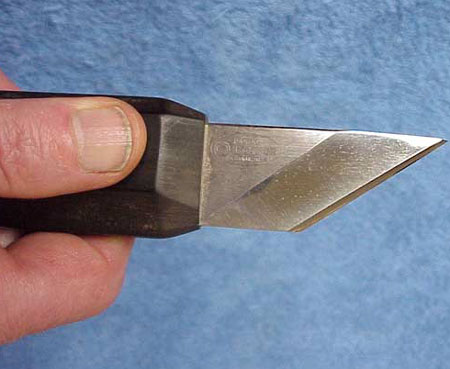
This violin bow makers knife has a one-inch wide blade that's a full 3/16" thick!
It's completely flat on the back side, and is slightly hollow ground, but the acutal
cutting edge is provided by a secondary bevel. The cutting angle is very steep, that
is, not acute. In using this knife, the bowmaker slides the flat edge along the bow
stick, and takes light cuts. Because it has a steep cuting angle, it is less likely
to tear out grain, and operates almost like a plane. When curving the cut, this blade
really stays on track. I bought just the blade and made my own ebony handle. Oh,
yes, it was made by Daniel O'Connor of Kaufman, Texas, and cost me about sixty bucks.
More
1
2
3
4
5
Back to Index Page






